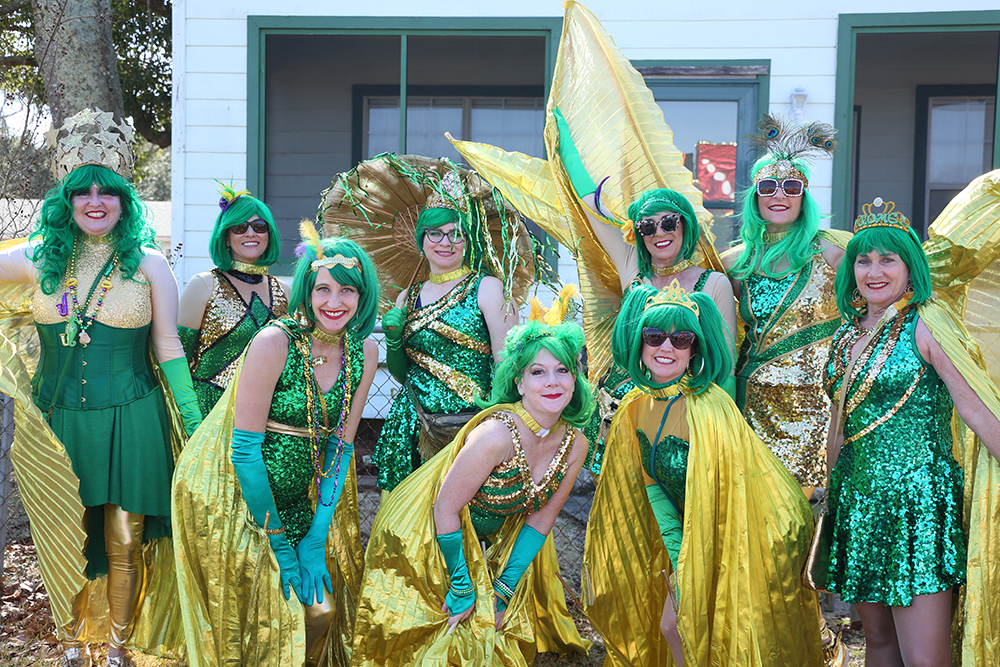A longer version of this article was originally published in Issue 10 of the Journal of Ethnic American Literature. Adapted and republished with permission.
It was a sunny day in mid-February 2018, and I woke up early to make the three-hour drive from Jackson to the Mississippi Gulf Coast. I had been invited by the Raw Oyster Marching Club to walk with them and take photographs in the Krewe of Real People Mardi Gras parade that passed through downtown Bay St. Louis. It was exciting to be both a participant and an observer, with both beads and a camera around my neck; throwing a few beads to parade-goers in between taking photographs of the festivities. The photos in this article were taken on that day, my first Mississippi Mardi Gras. Months later, I came back to the coast to learn more about the Raw Oyster Marching Club (ROMC) and to interview the founder and a former captain of the club, Martha Whitney Butler and former member, Ann Dinwiddie Madden. We discussed ROMC through the lens of local history, craft, performance, and community building.
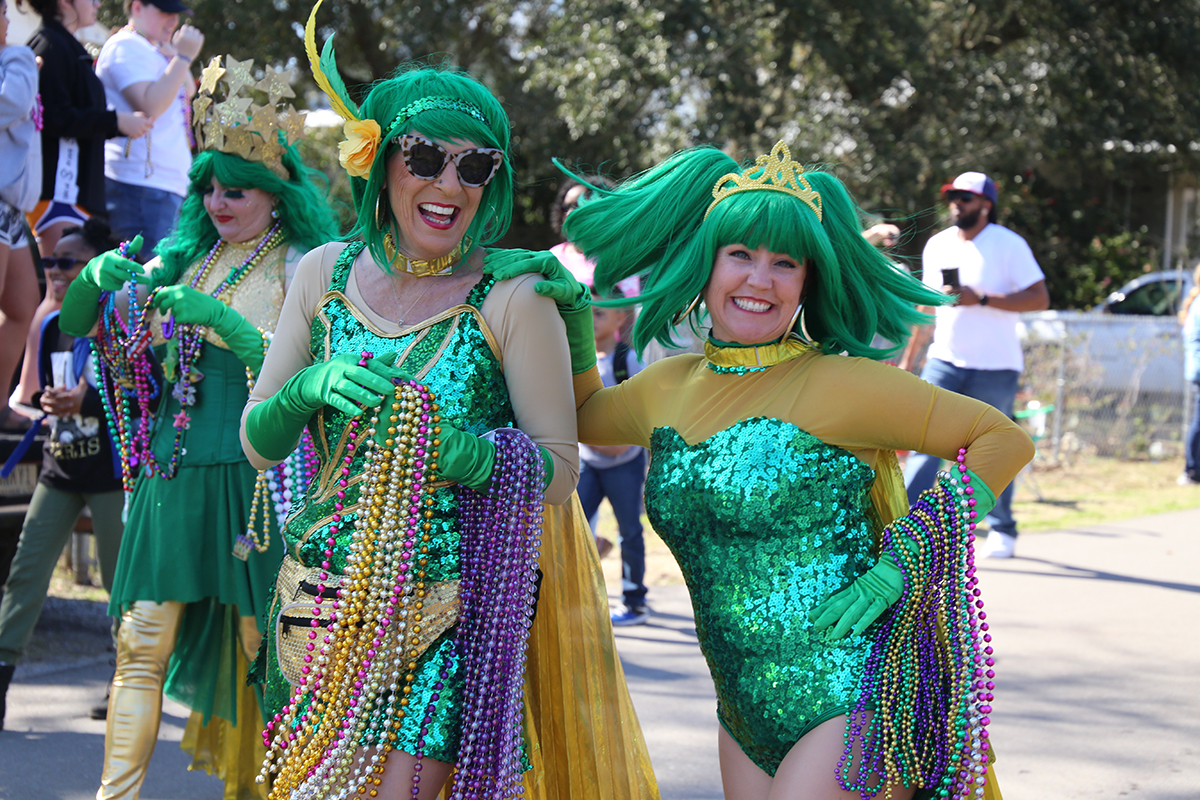
Above (main image): A group photo of several members of the ROMC who participated in the Krewe of Real People parade on Mardi Gras.
Right: Members of the Raw Oyster Marching Club passing out beads to parade goers in Bay St. Louis.
All photos by Maria Zeringue, 2018. Courtesy of the Mississippi Arts Commission
During Carnival season, many coastal communities host parades that are often sponsored and operated by local carnival organizations called krewes. Members of the krewes decorate the floats and ride in the parades, throwing beads to onlookers. In addition to floats, these parades also include high school marching bands, processions of Mardi Gras Kings and Queens who ride in cars or SUVs throwing doubloons, and walking krewes like the Raw Oyster March Club.
Members of the Raw Oyster Marching club wear colorful green and gold costumes, and during parades they perform dance routines and give handmade items to parade-goers. The ROMC also has roots in burlesque. During our conversation, Martha Butler told me that she first started a burlesque group in Bay St. Louis, which was called Big Sleazy Burlesque. As the burlesque group became more popular, Martha said that they transitioned into “a family friendly marching group for parades” to attract more participants and to have a broader appeal in the area. From there, members of Big Sleazy Burlesque formed the Raw Oyster Marching Club in 2014. In their inaugural year, they performed in the Mystic Krewe of the Seahorse Lundi Gras 1 parade in Bay St. Louis.
The club’s burlesque roots are a great example of how local history and culture are put on display during Mardi Gras. The ROMC is heavily inspired by the life and work of a local burlesque performer, Kitty West, who was born in Bay St. Louis in 1930. In her teens, she left Mississippi for New Orleans, and became a dancer at various Bourbon Street clubs. 2 She was most famous for her role as Evangeline the Oyster Girl at Stormy’s Casino Royale on Bourbon. During West’s act, she would arise out of a giant oyster shell and dance with a large pearl. She even dyed her hair green to evoke the look of seaweed. As Evangeline the Oyster Girl, West was the headlining act at Stormy’s for about a year when the club began promoting a new, rival aquatic act: “Divena and her Sensational Aqua Tease”. In Divena’s act, she would perform as a mermaid in a water tank. 3 West was so upset that Divena was given top billing that one night during Divena’s performance, West rushed on stage and began striking at the tank with an axe until she broke the glass. West was arrested that night and charged $10 for her transgression, but Divena ultimately forgave her. 4 The story of West attacking Divena’s tank received national attention when it was published in Life magazine, and her show became tremendously popular. It was the defining moment of West’s career. 5 Martha Butler spoke with me about Kitty West’s influence on ROMC and what she means to the group today.
She was a hero for that, you know. Who has green hair in the 1940’s?

Left: A decorated cardboard cutout of Kitty West is attached to a golf cart that rides alongside the ladies of the ROMC during the Krewe of Real People parade. This parade passes through Bay St. Louis on Mardi Gras day.
Maria Zeringue (MZ): Tell me about Kitty West and how she was an inspiration?
Martha Whitney Butler (MWB): She was wonderful. I’d heard of her, of course, when I was researching burlesque, and then I realized that she lived here in Bay St. Louis, which was huge. And then one day I looked her up in the White Pages and just called her and said, ‘Hello Kitty West.’ And she said, ‘Oh hello.’ And she’s wonderful, she’s one of the coolest people. She’s still got it, you know? She can still gyrate for sure. She’s gyrated in my shop before. She’s an amazing person. She’ll teach you how to dance and everything. So, she’s great, she lives in Bay St. Louis, so we love local, and she, of course, was the real original Evangeline the Oyster Girl. She was a hero for that, you know. Who has green hair in the 1940’s? …While you can go around being a badass, we like that she still had that class, and you know, she’s still a sweet Southern girl. We all really love her, and she still makes my day every time I talk to her.
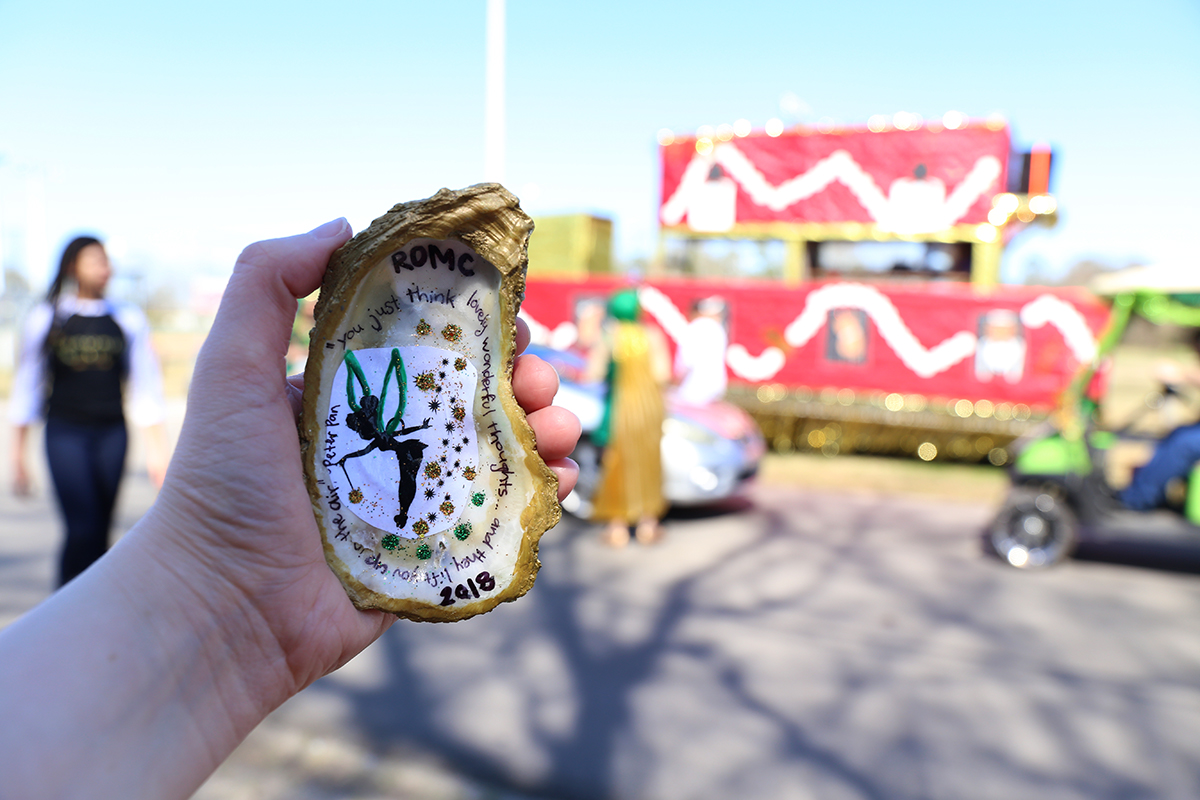
Right: The 2018 theme for the Lundi Gras parade was “Mystic Krewe of the Seahorse goes Pirating in Neverland.” This decorated oyster has Tinkerbelle painted on it and a quote from Peter Pan to fit in with the parade’s theme.
Kitty West was also the source of inspiration for the two Mardi Gras throws that ROMC creates every year for their parade season: the oyster and the axe. The decorated oysters that ROMC is known for is an homage to the giant oyster that Evangeline had in her act as well as the importance of the oyster to the seafood industry on the Coast. 6 The axe is a nod to the altercation between West and Divena, and the green wigs that ROMC members wear during parades are modeled after West’s seaweed-green hair.
ROMC members take the time to make their throws by hand and create something special for parade-goers. Oysters are their primary Carnival throw, and they are colorful and decked out in paint, glitter, sequins, or small jewels. Some oysters have coastal imagery painted on them such as a crab while others are adorned with the Mardi Gras colors green, purple, and gold. Oysters are also decorated according to the theme of the Krewe of the Mystic Seahorse, the Lundi Gras parade in which ROMC annually participates. They often come wrapped in a small clear plastic bag and closed with a piece of ribbon or a colorful twist tie. Martha and Ann spoke with me about the process of making their carnival throws.
MZ: Does each person have to make a certain number of oysters?
MWB: Each member makes at least 25 oysters every parade.
MZ: Oh, every parade. So even when you do multiple parades in a season?
MWB: Oh yeah, it’s a thing. There are some girls though, they make 200 oysters. They love it.
Ann Dinwiddie Madden ADM: Well, a lot of people really enjoy the oyster making process. So, groups will gather and have just a crafting night or something and then get together; pool all their glitter and stuff; and then just make a ton of communal oysters.
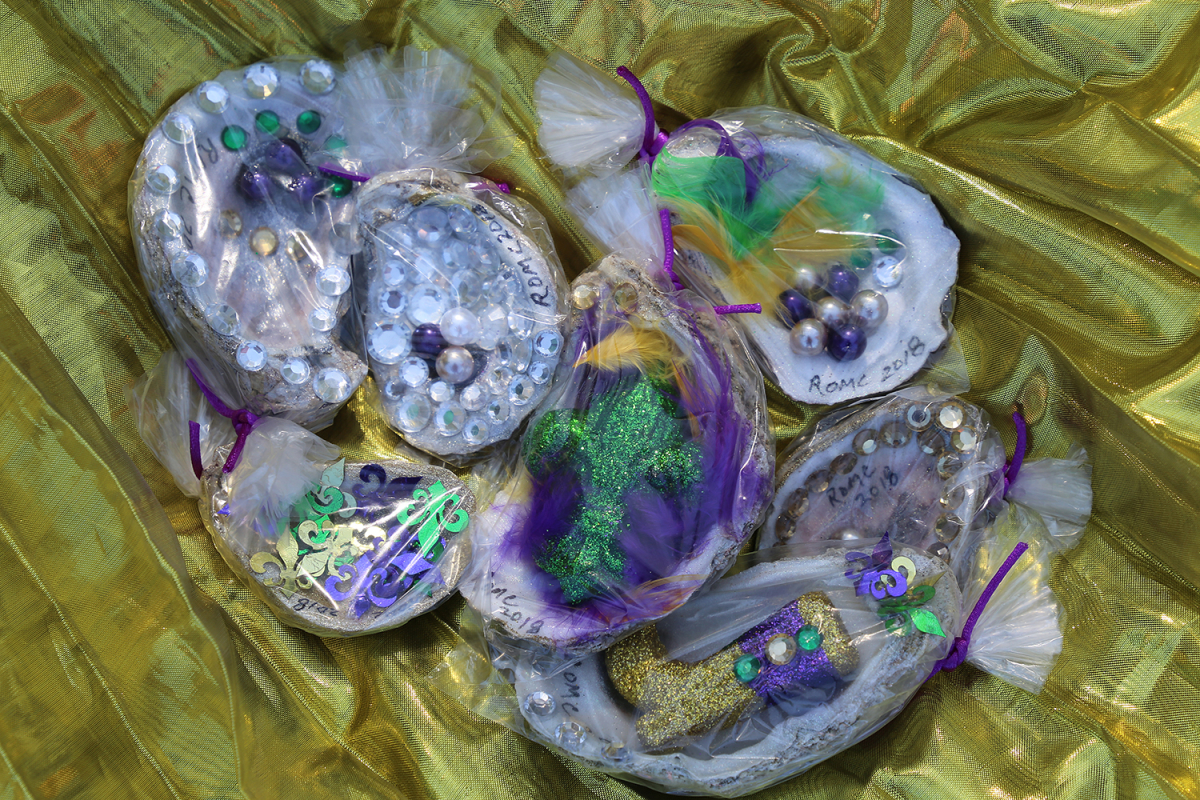
Above: This photo shows a selection of ROMC oysters that are decorated with a Mardi Gras theme and use the Carnival colors of purple, green and gold.
A lot of people really enjoy the oyster making process. So, groups will gather...pool all their glitter and stuff; and then just make a ton of communal oysters.
MWB: Yeah, it’s wonderful, you have a year of supplies. Think about all the stuff you accumulate over the year, that year before the parade, it’s amazing.
At this point in our conversation, Martha was talking about an oyster that was gifted to her by a fellow member of ROMC. The oyster was decorated with a hatchet on it, so Martha started telling me about their special throws that they only make for the Krewe of the Mystic Seahorse parade.
MWB: [My oyster] had this sterling silver hatchet on it. That’s one of our symbols, the hatchet, because Kitty West popped [Divena’s] tank. We hand out hatchets as well. We have these golden axes that we hand out that are super special. They’re a lot harder to deal with. But we hand them out. I think we hand out a dozen of them.
ADM: How do you pick who gets those?
MWB: You just have to be extra. And nobody really knows what the meaning is because they don’t really know our story.
MZ: So only twelve a year or twelve a parade?
MWB: Twelve [hatchets] just for Lundi Gras. We don’t hand them out at any other parade. So really, they’re the most coveted thing.
MZ: As for the oysters, where do you get them? From restaurants?
ADM: Crystal Seas has been a good source. 7
MWB: Oyster places. Restaurants. My husband’s a chef, so.
ADM: The beach. I got mine last year just at the beach.
MWB: Everyone will say that Waveland 8 beach has the better ones.
ADM: Maybe, but I found plenty at the end of Carroll Avenue.
MWB: I get my husband at the restaurant he works at to run them through the industrial dishwasher and clean them off for me. But most of the time people dump them off on you; and you’ll forget that they’re there; and you’ll smell them.
ADM: But at the beach, generally they’re already bleached out.
MWB: Yeah, the beach is the best bet. They’re clean, they’re done. I mean, I’ve scrubbed so many oysters with bleach and it’s so nasty. So, beach picking’s probably the best.
MZ: How do you go about decorating the oysters? Do you decorate the oysters according to the theme chosen by the parade organizers?
MWB: Yes, we do. And then, our only requirement is that the oysters have ROMC BSL and the year on them. Because we have collectors. We have real fans that are like, ‘I’ve got every oyster since the burlesque group marched in the parade.’ They’re amazing. [to Maria] You probably have some? I mean, they’re works of art.
MZ: Yeah, I do. They are awesome.
MWB: Last year we had people with signs that said they wanted an oyster, which is cool.
The conversation then shifted to discussing the costumes and choreographed performances of the ROMC. Beyond Mardi Gras celebrations, the group marches in St. Patrick’s Day and holiday parades.
MWB: Our colors stay the same no matter what. But [on] St. Patrick’s Day, we wear green and gold. Mardi Gras, [we wear] green and gold, and you can add some purple to it. And Christmas, add red to it. It’s very interchangeable, so it works perfectly for us. And it keeps the cost down if you want to keep the cost down. It’s very doable. You know, with the songs, we’ll do a theme. We had one parade that [the theme] was superheroes. That was wonderful. So, we had the superhero parade. We picked a song according to that. We’ve had like a ‘Bars of the Past’ [theme], and we were Studio 54. Which, we didn’t know that it was ‘Bars of the Past in Bay St Louis’ (laughter). So, we’re like, walking down the street throwing white glitter to people, dancing disco. And they’re like, ‘What’s Studio 54?’ It didn’t matter to us because when you’re in it all, it’s just like being in a snow globe full of glitter. It’s just like I’m in my own element. It goes by so fast.
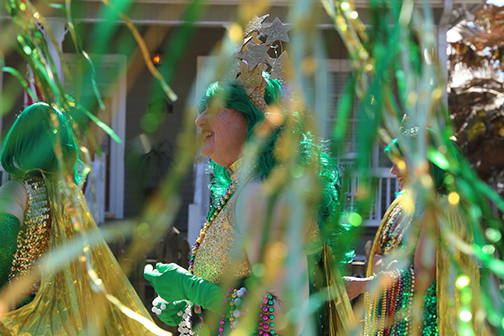
Right: The costumes, throws, and decorations of the ROMC caravan provide a burst of color, glitter, and shiny streamers on the parade route.
I think the most beautiful thing about us...
is that we have been able to find a place for everybody.
MZ: How many people did you have when the group first started?
MWB: About 25 people, which was a lot, you know. That was a lot. I do like to say that we take new members every year, so we are growing. But we are controlled growth. Our reputation means a lot to us here. It’s a small town, so we’re not able to be as wild and crazy as the New Orleans groups, unfortunately. We started at 25 [members] and now we have over fifty, 9 which is cool. September is when we open up our applications, and then in October we choose our new recruits. And that’s that.
MZ: How do you choose the new recruits?
MWB: We have an application process. We’re not picky, you know, we just want people that are doers, we want people that are going to show up and show out. That’s all. You don’t have to know how to dance. I think the most beautiful thing about us right now, currently, is that we have been able to find a place for everybody. If you are not able to dance, you can walk with a banner, or you can stand in the back and twirl your heart out. Or you can decorate your three-wheel bicycle as a unicorn and parade right down the street with us. You can twirl fire, or whatever you want to do. So, everybody is finding their place. Everyone is finding their rhythm within the organization. We don’t tell somebody, “Oh you can’t do that.”
I think the biggest thing that I hear the most whenever people try to join is ‘I can’t dance!’ Well, we were all like that. None of us could dance. Are you kidding me? We didn’t know the first thing about it. I think half of our--well--I think all of our routines were like Zumba routines [and] dance-dance revolution moves. That’s all we were at first. And now we have people that jump in and they’re wonderful. And they can choreograph. We’re finding more people, and everybody’s finding their talent.
We ask them when they apply with us, like, ‘What are your talents?’ We want to know, ‘Have you ever danced before?’ ‘List any groups you’re a part of.’ And then we’ll even say, ‘What does your partner do?’ Because we want to have this big roster. If your wife or husband is in a band, yeah! We want to have that band at our function or that kind of stuff. It’s really a community for us, and then everybody hangs out with each other. So, all these people that are moving here I think find a lot of friends in the group, which is really good for them. That’s fun. You never know who’s going to join, so you find out during the application process, like, ‘Who is this person?’ They sound so cool, you know, ‘Where did this person come from?’ That kind of stuff. We also have meet and greets where it’ll be for the public. You do have to have references to get in, but we’re going to give you an opportunity to come out and meet everybody and make friends. It’s fun, and you can see if you can vibe with us.
MZ: Would you say that most of the members are from Bay St. Louis or the Coast?
MWB: Yeah, I would say they’re mostly from Hancock County. We have a lot that drive over the beach from the Pass. 10 We have a couple from New Orleans now, but they live here part-time too.
MZ: What is the age-range of the group?
ADM: We’ve got all ages. [To Martha] What is our membership?
MWB: 21 and up.
ADM: Okay, so we’ve got them from twenty-one up through…
MWB: Eighty. Eighties. Twenty-one and beyond!
ADM: We have multiple generations. We do have a mother-daughter thing.
MWB: Yeah, we’re very open and accepting. And like I said, we’re going to utilize the talents of our members. We’re going to make sure that everybody has a place.
ADM: All walks of life.
MWB: All walks of life.
MZ: How often do you practice?
MWB: Now, during a parade season, we start about 6 weeks before the parade. Sometimes it’s 4-6 weeks depending on the parade and how much time we have in between parades. And everybody’s been so generous with their time and their talent. So, what we have started to do is we have several choreographers, and each choreographer will take a day--just because you have so many people--and you want to be able to offer practice to everybody, because you do have to make the practices. So, I would say, you have the option to practice about 4 times a week for 6 weeks. But you’re mandatory [to practice] two times a week for about 6 weeks.
MZ: So, when you have people that are out of town, what do they do?
MWB: Well, we offer so many options that you can ‘half-shell,’ and what half-shell means is that you just hand out oysters to people, because that is a huge thing. That is the biggest thing because when we’re dancing, we can’t hand out the oysters. It messes up our routines, [and] we don’t have a place to carry them. So, one of our very most important groups are the half-shells.
ADM: And the half-shells are in costume.

Left: Members of the Raw Oyster Marching Club passing out beads to parade goers in Bay St. Louis.
MWB: The half-shells are in our costume, and they hand out all the shells. I mean they’re the people that you want to see at the parade, because they’re going to give you the oyster. So, they’re huge. That’s huge for us to have people that don’t want to dance, who just want to hand out the oysters.
ADM: You can’t throw the oyster at people.
MZ: Is that a liability?
MWB: Oh yeah, it’s dangerous. You learn so much from the parades. Like you really learn quickly what to do and what not to do. So now we’re at the point where we gift-wrap our oysters pretty much. We put them in bags now and hand them to people. And it’s great, I mean kids love [it]… and I will say, we don’t give a lot to kids. We try to give them to the adults that come out because we think they’re the ones that deserve the trophy. Because when you hand a kid an oyster shell at a Christmas parade, they’re like, ‘Where’s my candy.’ You know, it’s very defeating, so we try to give them to the adults [as a] ‘thanks for coming out, thanks for bringing your family.’ And the kids love to watch us dance and stuff, so, it’s fun. I mean we are comical, entertaining, we got it all. Beautiful. We just have it all. And people do really love us, and we just love to entertain. It’s fun. We genuinely have a really good time during marching season and out of marching season. It's good community for the ladies.
At the end of our interview, I asked Martha and Ann if there was anything they would like to say about the Raw Oyster Marching Club, and Martha added this wonderful quote:
MWB: So, you know, we’re evolving every year. It’s something new for us. And that’s because you’re getting all these members, and everybody has cool plans and ideas. It’s cool. A lot of the girls are just so talented. You’re dealing with fifty incredible people. And it can be very shiny and glittery and colorful. Everyone gets along really well. It amazes me with that many people for everyone to get along so well. Because, we come together for one thing, and it’s to entertain people at the parades. And when you’re doing that, it doesn’t matter what you think or what you believe, or what your political stance is, any of it. We just want to have fun. So, it’s just a bunch of girls having a good time. And then we do try to make a difference in our community.

Above: A group photo of ROMC members in their green and gold costumes. This photo was taken at the Krewe of Real People parade on Mardi Gras day. Martha Butler is pictured on the top row, fourth from left.
Martha’s words summarize how important this group is for the women who participate in the ROMC and the impact that the group has had on the community. Beyond entertainment, they give back to Bay St. Louis by supporting local artists and giving out scholarships to youth dance groups. Through their creativity and artistry, the club has developed a loyal fan base of Carnival enthusiasts and oyster collectors who wait each year for the chance to get another decorated throw. It’s been almost a decade since their first parade, and they have now become a local fixture in the Mardi Gras festivities on the Mississippi Coast. Kitty West sadly passed away in 2019, but she would be proud of what this group has accomplished. What started out as a way to honor West’s legacy has grown into a fun community tradition that hopefully will continue for years to come.
Resources
Projects
Zeringue, Maria. “Interview with Martha Whitney Butler and Ann Dinwiddie Madden.” Conducted on 27 Aug 2018.
Footnotes
- ^ Lundi Gras falls on the Monday before Mardi Gras. In French, Lundi translates to Monday and Mardi translates to Tuesday. Lundi Gras is a major day of Carnival as it is the second-to-last day of the season. Translation by author.
- ^ Source: “The Original.” Evangeline the Oyster Girl, New Orleans Burlesque, 2021. https://neworleansburlesque.wixsite.com/oystergirl/original
- ^ Source: “RIP Kitty West (1930-2019).” Burlesque Hall of Fame, 2019. www.burlesquehall.com/rip-kitty-west-1930-2019/
- ^ Source 2: “The Original.” Evangeline the Oyster Girl, New Orleans Burlesque, 2021. https://neworleansburlesque.wixsite.com/oystergirl/original
- ^ Source 3: “The Original.” Evangeline the Oyster Girl, New Orleans Burlesque, 2021. https://neworleansburlesque.wixsite.com/oystergirl/original
- ^ Source: “Our History.” Raw Oyster Marching Club, 2018. www.romcbsl.org/history/
- ^ Crystal Seas is a seafood wholesaler specializing in oysters. The business is located in Pass Christian, Mississippi.
- ^ Waveland is a coastal town located just west of Bay St. Louis.
- ^ Martha Butler told me recently that as of 2023, the ROMC has grown to over 70 members.
- ^ The Pass is a local term for the coastal town of Pass Christian, which neighbors Bay St. Louis to the west.

